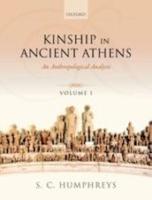
OUP (2018, two vols.) h/b 1504pp £250.00 (ISBN 9780198788249)
This impressive two-volume work (thirty five years in the writing) sets out to cover ‘Athenian kinship from Drakon and Solon to Menander (with some references to later developments)’. In fact it does much more than that, presenting a comprehensive and magisterial study of three centuries of Athenian society. Drawing on a wealth of literary, epigraphic and archaeological material, it covers almost every aspect of relationships between Attica’s inhabitants: how they interacted within the spheres of politics, law and religion; how they were organized into ‘corporate groups’ (tribes, trittyes, phratries, genê and demes); and how their nature was affected by historical events such as the reforms of Cleisthenes and the Peloponnesian War. At the same time it incorporates useful discussion of areas such as changing trends in archaeology and anthropology as well as problems arising from hasty rescue digs, sketchy publication of findings and the uncertain provenance of many stelai. There are also occasional (yet intriguing) comparisons with other societies including Sparta, Rome and fourteenth-century Florence.
Each volume has its own slant. The first is relatively schematic. It begins with a consideration of the reforms of Draco and Solon as well as the socio-economic pressures that gave rise to them (including disputes among members of elite families, class tensions and crises arising from population growth and intensified production) before considering legal and social interaction (including adoption, guardianship and marriage). While most of the literary evidence comes from fourth-century forensic speeches (H. uses no fewer than fourteen case studies to examine and explicate her arguments), there is valuable discussion of earlier trends, including Pericles’ citizenship law of 451 BC. Sections on what H. terms ‘ritual’, embracing names (including nicknames and an intriguing note on overlapping names of girls and triremes), rites of passage, burials, commemoration and religious festivals, are followed by considerations of political relationships both informal (including young men’s hetairiai—not least those involved in the scandals of 415 BC—political marriages and curse tablets) and formal (ostracism, serving as ambassadors, generals, or council members).
The more diachronic volume two addresses so-called ‘corporate groups’, culminating in a splendidly wide-ranging study of the ten Athenian tribes and their affiliated demes and settlements. Here as throughout the book H.’s arguments are enhanced by schematic family trees and diagrams (166 in total) showing their interconnectivity. In addition there are 5 appendices, a bibliography (running to 136 pages) and indices of subjects, names (persons and deities), sources and monuments.
One of my few criticisms (apart from the occasional inexplicable change of font size throughout the book) is that at just over 16 pages and 5 and a half pages respectively the indices of subjects and names are frustratingly inadequate. It is, however, the only inadequacy of the entire book, and although H. admits with surprising candour that ‘two of OUP’s readers felt that my analysis was strongly imprinted by the environment of the 1980s in which the book was conceived, and that this made it seem “outdated”‘, she is certainly right in asserting that ‘changes in anthropological focus [do not] seriously affect the utility of my analysis’. Indeed, an invaluable reference tool and thought-provoking read, this book will surely take its rightful place on shelves of libraries and scholars seeking an in-depth understanding of the social history of classical Athens.
David Stuttard
